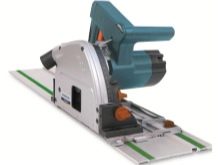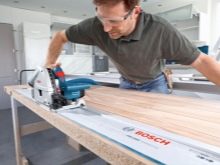Features and selection of plunge saws

When processing wood with a power tool, the problem of accurate cutting often arises. Unfortunately, even modern disc models cannot boast of a perfectly executed job. This is due to the impossibility of exercising proper control over the position of the cutting tool relative to the workpiece. To solve the problem of sawing accuracy, a submersible circular saw was invented and launched into production, which immediately gained popularity among woodworking craftsmen and became a sales leader.



What it is?
The plunge-cut saw is a type of electric circular saw and is intended for cutting wooden surfaces not only from the edge, but also from the middle of the workpiece. A feature of the device is the ability to adjust the depth of the cut, which is carried out by positioning the disc in a predetermined position relative to the base plate.
Thanks to the adjustment mechanism, the depth of the cut can be adjusted down to the millimeter, which is impossible to achieve with a conventional tool.


The principle of operation of the plunge saw is quite simple and consists in the following: the operator sets the required depth and the desired inclination of the working disc. Then the tool is turned on, removed from the lock, inserted into the wood and carefully guided along the marked line. When the motor is started, the working shaft begins to rotate together with the disk mounted on it and cuts the surface. Many modern models of plunge-cut saws are equipped with a speed adjustment function, so that the number of revolutions can be changed depending on the type of material being cut.
At the end of the work, when the pressure on the disc weakens, the cutting unit is spring-loaded and hides behind the sole. The area of application of plunge-cut saws is wide enough. The tool is used for making furniture, cutting grooves, cutting shaped openings and gutters in wooden products, as well as for repairing roofs and working with laminated materials.


Device
The plunge-cut circular saw is slightly different in structure from a conventional circular tool and is equipped with a specialized assembly. Thus, the accuracy of cutting and the absence of backlash provides a complex precision mechanism, which significantly increases the cost of the tool. The rest of the saw design is similar to the basic models. The device consists of a sturdy case, where an electric motor is located, during the operation of which the torque is transmitted to a special shaft. A locking device is located on this shaft, which reliably holds the working disk and does not allow it to move relative to the shaft axis.
The saw blade, when not in working position, is located under the protective cover and is located in the same plane with the mounting base. This design allows for more accurate positioning of the tool on the working surface compared to conventional circular models. All controls are located on one panel, which makes working with the device very convenient and understandable.
Some models of plunge-cut saws are equipped with two discs at once, which allows you to cut a board of any width, performing two cuts at once in one pass.


Without exception, all devices are equipped with a spring-loaded bottom base, due to which, if the cutting disc hits a nail or other third-party element, the device will stop working in time. The features of plunge-cut saws include the function of tilting the disc, which is especially convenient when it is necessary to manufacture products of complex configuration.
In addition to the standard design and traditional set of functions, many modern devices often have additional options. They do not fundamentally affect the operation of the saw, however, they make its use more convenient and safe. Among them are backlighting, a speed controller, rulers of different sizes and a chip sucker that forcibly removes sawn products.


Advantages and disadvantages
High consumer demand for plunge-cut saws and positive feedback from professionals is due to a number of important advantages of this equipment.
- The ability to perform longitudinal and transverse cuts significantly expands the scope of use of such models and allows you to perform complex curved cuts. The only limitation when cutting non-standard shapes is the rounding radius. For plunge-cut saws, it should not be too small.
- Due to the most accurate positioning of the cutting blade relative to the working surface, the material is cut with pinpoint accuracy, which no other type of saw can do.
- Due to the peculiarities of the location of the working disc, the plunge saw can work directly near the wall, which simple circulars cannot boast of.
- By equipping all plunge-cut models with a finishing disc, the cuts are completely smooth and neat. Burrs, roughness and small cracks are excluded.
- Due to the equipment of many models with a guide rail, the geometry of the formed cut is not disturbed and the wood is cut as accurately as possible. In addition, to prevent lateral play of the saw blade, the tool design provides for the presence of special eccentrics.



- The cleanliness of the workplace when working with a plunge-cut saw is due to the presence of a chip sucker, which instantly draws in the formed sawdust and fine wood dust.
- The high power of 1000 W and more allows cutting wood pieces with a thickness of 6 centimeters or more. In addition, using the plunge model, it is possible to cut plastic and plexiglass, although the main specialization of the tool is woodwork.
- Many models are equipped with a stepless adjustment of the cutting angle, which is carried out using a screw mechanism. This allows you to quickly and accurately measure the desired angle and no less accurately cut it.
- The high safety of using the devices is due to the fact that most models are equipped with double protective insulation, electronic motor protection against overloads and the function of stabilizing the number of revolutions at high loads.
However, like any other electric tool, submersible models also have drawbacks. The disadvantages include too high, in comparison with conventional circular saws, the cost and complexity when cross-cutting too narrow workpieces, if their width does not exceed the support of the saw.



What are they?
Submersible models are classified according to several criteria, the main of which is the way the device is powered. According to this criterion, devices are divided into two types: network and battery. On-line models are powered by an electrical source and offer higher power and performance. The advantages of such models include the absence of the need for regular battery charging and low weight. The disadvantages include the inability to use the tool in the field, as well as in any other places where there is no electricity or access to the outlet is difficult. The rotational speed in network models varies between 4-5 thousand rpm, and the average power is about 2 kW.


Cordless models operate on battery power and are slightly inferior in power to networked models. One battery charge lasts about 50 minutes, which forces you to interrupt the process and waste time on charging. A way out of the situation can be a replaceable battery, which allows you to continue working for a while. The battery voltage is typically 36 V and the engine speed ranges from 2500 to 6300 rpm depending on the model. The cutting depth for such devices varies from 38 to 60 mm.


Another criterion for differentiation is the size and weight of the models. On this basis, mini-saws, middle-class models and heavy units are distinguished. Weight indicators directly depend on the engine power and the type of power supply of the device. The more powerful the product, the more it weighs.


How is it different from a circular one?
The main difference between a plunge-cut saw and a traditional saw lies in the position of the blade. It immediately catches your eye and does not allow you to confuse the models. If in a conventional saw, although it is closed from above with a protective casing, it is still clearly visible from below, in submersible models it is located above the level of the sole and is completely covered by a casing. The horizontal position of the disc relative to the sole also differs: in plunge saws it is maximally displaced to the edge, while in ordinary saws it is located almost in the middle.
The next difference is the principle of work execution. So, if, when using traditional models, filing starts from the edge of the workpiece, then with submerged models it can be started from anywhere. To do this, you just need to set the required cutting depth parameters, unlock the "head" equipped with a spring mechanism, and place the device exactly in the place where you want to go deep into the wood. After the disc is immersed in the material, it is necessary to smoothly guide the device along the outlined line.


Another distinguishing feature of plunge-cut saws is the bar. This allows for even trimming of long boards, which cannot be achieved with a conventional circular, despite the fact that it has a parallel stop.
It should also be noted that the plunge-cut saws contain an anti-splinter insert and “clean cut” discs, thanks to which it is possible to form an absolutely smooth saw cut surface and completely eliminate the formation of chips.

How to choose?
Before going to the store for a plunge saw, you need to make sure it is needed again. This equipment is more intended for professional use, so when choosing a model for the home, as well as in case of rare use, it is better to opt for classic circular products.
If the decision to purchase a plunge-cut saw has already been made, then when choosing it, it is recommended to take into account a number of important factors.
- It is necessary to decide on the type of power supply of the model. So, if the device is bought for building a house, on the site of which there is no electricity, then the battery model should be chosen. Despite the lower, in comparison with network models, operational characteristics, the tool copes with its task quite well and cuts wood no worse than its electric counterpart.
- The next selection criterion should be the power of the device. So, for home use, you can limit yourself to models with a capacity of up to one kilowatt, while for professional equipment it is better to choose an engine of 2.5 kilowatts. It is also necessary to pay attention to the presence of an emergency shutdown mechanism, which will prevent overheating of the engine due to a sharply increased load.
It will not be superfluous to check the convenience of the control and adjustment mechanisms, as well as to make sure that there are service centers and the availability of spare parts for a particular model.


- Another parameter to which you need to pay special attention is the ergonomics of the model. And despite the fact that most instruments are equipped with a comfortable non-slip grip, it is better to hold the instrument in your hands and try it out.
- It is necessary to read an overview of the technical characteristics of different models and the popularity rating. It will be useful to read reviews of the selected model, as well as compare the cost of devices in different stores. The last recommendation is due to the fact that the price of the instrument is already considerable, and taking into account the dealers' markups, it can increase even more.

For an overview of the Makita SP 6000 plunge-cut saw, see the following video.













The comment was sent successfully.